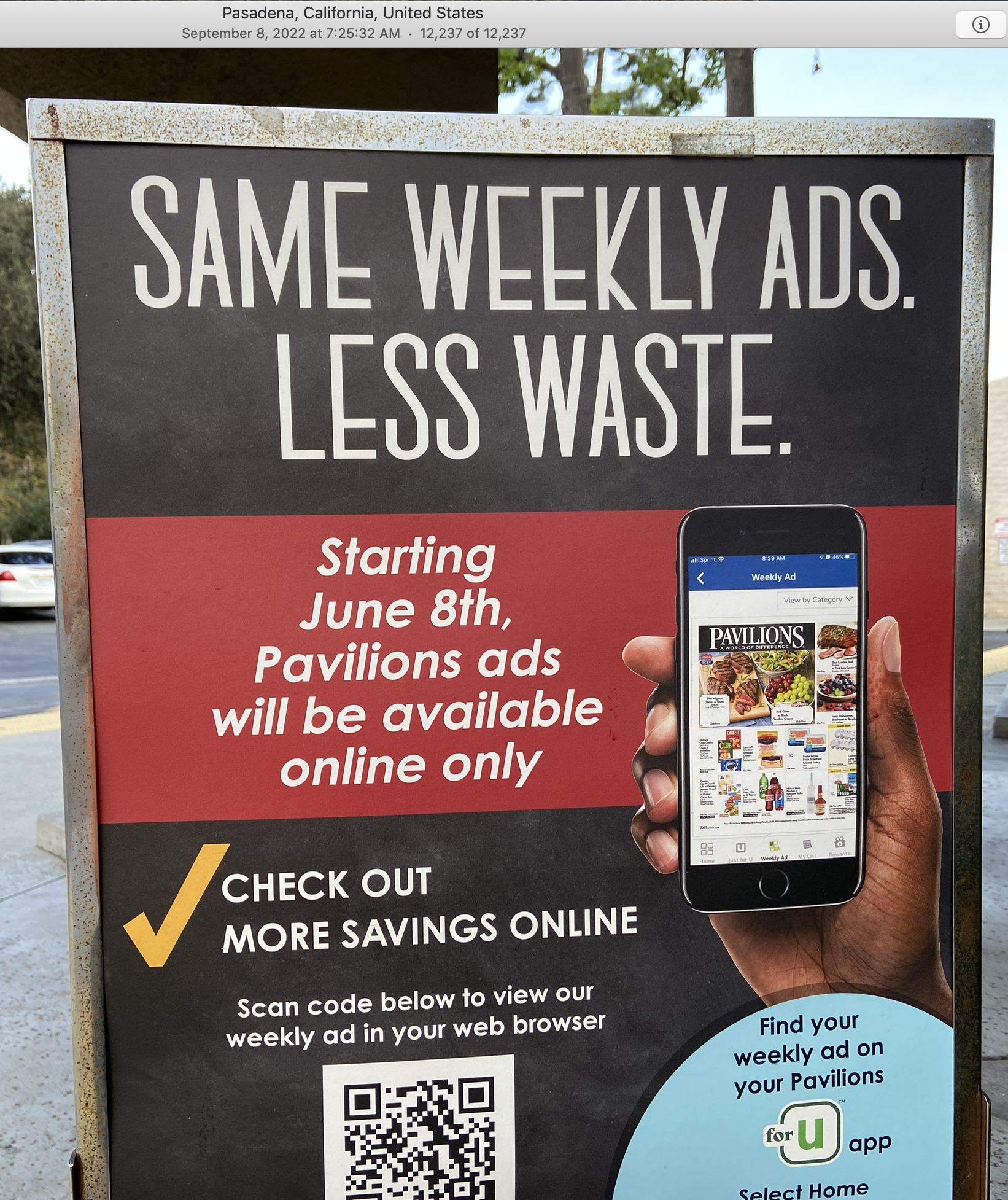
One morning a couple months ago, while I was staying at a friend’s house near Los Angeles, I was surprised to find the Los Angeles Times still being delivered there. The paper was smaller and thinner than it used to be, with minimized news, remarkably little sports, and only two ads in the whole paper. One was for Laemmle Theaters. The other was for a law firm. No inserts from grocery stores. No pitches for tires in the sports section, for clothing in the culture section, for insurance in the business section, or for events in the local section. I don’t even recall if those sections still existed, because the paper itself had been so drastically minimized
Economically speaking, a newspaper has just two markets: advertisers and readers. The photo above says what one advertiser thinks: that ads in print are a waste—and so is what they’re printed on, including the LA Times. The reader whose house I stayed in has since canceled her subscription. She also isn’t subscribing to the online edition. She also subscribes to no forms of advertising, although she can hardly avoid ads online, or anywhere outside her home.
Many years ago, Esther Dyson said the challenge for business isn’t to add value but to subtract waste. So I’m wondering how much time, money, and effort Pavillions is wasting by sending ads to people—even to those who scan that QR code.
Peter Drucker said “the purpose of a business is to create a customer.” So, consider the difference between a customer created by good products and services and one created by coupons and “our weekly ad in your web browser.”
A good example of the former is Trader Joe’s., which has no loyalty program, no stuff “on sale,” no human-free checkout, almost no advertising—and none of the personal kind. Instead, Trader Joe’s creates customers with good products, good service, good prices, and helpful human beings. It never games customers with what Doug Rauch, retired president of Trader Joe’s, calls “gimmicks.”*
I actually like Pavillions. But only two things make me a Pavillioins customer. One is their location (slightly closer than Trader Joe’s), and the other is that they carry bread from LaBrea Bakery.
While I would never sign up for a weekly ad from Pavillions, I do acknowledge that lots of people love coupons and hunting for discounts.
But how much of that work is actually waste as well, with high cognitive and operational overhead for both sellers and buyers? How many CVS customers like scanning their loyalty card or punching in their phone number when they check out of the store—or actually using any of the many discounts printed on the store’s famous four-foot-long receipts? (Especially since many of those discounts are for stuff the customer just bought? Does CVS, which is a good chain with locations everywhere, actually need those gimmicks?)
Marketers selling services to companies like Pavillions and CVS will tell you, with lots of supporting stats, that coupons and personalized (aka “relevant” and “interest-based”) ads and promos do much to improve business. But what if a business is better to begin with, so customers come there for that reason, rather than because they’re being gamed with gimmicks?
Will the difference ever become fully obvious? I hope so, but I don’t know.
One thing I do know is that there is less and less left of old-fashioned brand advertising: the kind that supported newspapers in the first place. That kind of advertising was never personal (that was the job of “direct response marketing”). It was meant instead for populations of possible customers and carried messages about the worth of a brand.
This is the kind of advertising we still see on old-school TV, radio and billboards. Sometimes also in vertical magazines. (Fashion, for example.) But not much anymore in newspapers.
Why this change? Well, as I put it in Separating Advertising’s Wheat and Chaff, “Madison Avenue fell asleep, direct response marketing ate its brain, and it woke up as an alien replica of itself.”
That was seven years ago. A difference now is that it’s clearer than ever that digital tech and the Internet are radically changing every business, every institution, and every person who depends on it. Everywhere you drive in Los Angeles today, there are For Lease signs on office buildings. The same is true everywhere now graced with what Bob Frankston calls “ambient connectivity.” It’s a bit much to say nobody is going back to the office, but it’s obvious that you need damn good reasons for going there.
Meanwhile, I’m haunted by knowing a lot of real value is being subtracted as waste. (I did a TEDx talk on this topic, four years ago.) And that we’re not going back.
*I tell more of the Trader Joe’s story, with help from Doug, in The Intention Economy.
Leave a Reply